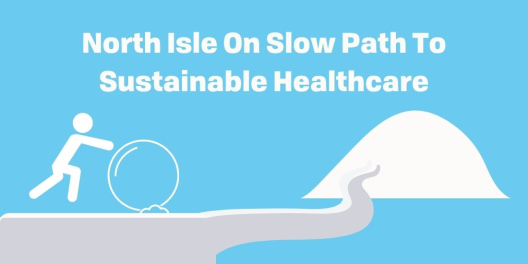Family physician Dr. Warren Bell took to Facebook last week to talk about the healthcare crisis. He works in Salmon Arm, so he has an insider’s view on the problem. But, like any good doctor, he’s looking at all sides. And he has a diagnosis.
He has a couple, actually. And they can help us understand why healthcare is such a mess right now, at least when it comes to doctors. The following is a summary of his post on Facebook.
The challenge
Healthcare in BC is struggling. More than 1 million people in BC don’t have a family doctor. Folks have to rely on walk-in clinics (that are closing) and emergency rooms. In fact, Canadians go to the emergency room far more than people in other wealthy countries.
But Dr. Bell is not alone. Emergency room doctors and nurses have been sounding the alarm about this for a while now. Instead of broken arms and bronchitis, doctors have to diagnose things like cancer in emergency rooms. And that’s not good.
Here’s the thing though, there should be enough doctors. Hundreds more doctors graduate from medical school every year than back in the 1970s. But BC’s population has only doubled in that time. So there are more doctors now than ever. Just not enough family doctors.
But the raw number of doctors in a region doesn’t tell you how good the care is.
If the healthcare system is a mess, adding more doctors won’t fix the problems.
How many primary care doctors are there?
Being a family doctor is hard. And you have to work way harder to make the same money as a specialist.
Sure, specialists are important. They know a ton about very specific things, like knees and hearts and cancer.
But primary healthcare is harder. Family doctors care for folks who know they have a problem, but they often don’t know what the problem is yet. And it’s the family doctor’s job to figure that out.
Human bodies are super complicated. So it’s way harder to figure out what’s going wrong with someone’s health and then send them to the proper specialist.
Becoming a doctor is extremely expensive
Medical school wasn’t always so expensive. For decades, doctors were seen as a public good. As a result, governments used to subsidize medical schools heavily. Medical students paid tuition, but the cost wasn’t outrageous.
Now, governments give universities less public money, so they’re forced to operate more like businesses. They charge a boatload for medical school. Lots of med students finish $300,000 in debt.
That debt creates two big problems:
1) New doctors are forced to choose jobs that will make them more money. They might stick with walk-ins or try to specialize to pay off their debt. They are less likely to become a family doctor who takes on new patients because that won’t pay all their bills.
2) Folks who might make amazing doctors do something else because they can’t afford to go to medical school.
The fee-for-service model makes our problems worse
Lots of new doctors start off with debt the size of a big mortgage.
Then they start practicing and come face-to-face with BC’s “fee for service” model. Basically, doctors are paid the same for a short visit as they are for longer ones. So, doctors push for more shorter visits.
To keep things short, some doctors will only focus on one problem at a time, even if someone comes in with multiple things going wrong. And these short visits that focus on single problems make it harder for doctors to diagnose complicated health issues.
So doctors see more patients in a day, but for more minor problems. It creates a backlog in the system.
But, Dr. Bell says, “a lot of new doctors are not happy with the fee-for-service system, and would prefer to be paid a salary (or something similar) so that they can take more time with a given patient, and concentrate on quality rather than quantity of visits.”
It’s the older and more established doctors who want to keep things the same. They don’t want to hand any of their power over to anyone else.
What’s the prescription?
Solution #1: Financing:
We can start by subsidizing medical school. Don’t charge so much money for tuition, and we won’t have so many doctors with so much debt. They’ll have more time to focus on caring for patients instead of making interest payments.
That’s how they do it in Cuba, and Cuban doctors are famous worldwide for their level of care.
As a doctor, Dr. Bell also says that there’s something really powerful about knowing that your country values what you’re doing so much that they’re willing to support you while you learn how to do it.
Solution #2: More Teamwork:
We can also have doctors working in teams instead of working on their own.
People get better care and are healthier in countries where doctors, nurses, and other experts work in teams. That’s how healthcare works in Costa Rica. And even though they have 1/4 of Canada’s GDP, their people live longer, healthier lives.
Those teams can include nurse practitioners. Nurse practitioners have been part of Canada’s healthcare system for 100 years. But for the longest time, they only worked in places where doctors weren’t excited to go.
Doctors are getting touchy now that they’re starting to become mainstream and work in urban centres.
“My profession,” Dr. Bell states, “especially in BC, has been both prideful and also overly sensitive, for reasons noted above, to any suggestion that they are not the single most important and valuable part of the health care team.”
But working in teams with nurse practitioners and other healthcare professionals can create solutions to the healthcare crisis that we can’t see right now. And it will keep folks in the province healthier.
Sure, that might mean doctors have to give up some of their status. And they might make less money. But they would have less debt, it would be easier to practice, and their patients would get better care.
These changes would take time, but they would open the door to a healthier future for folks in this province.










